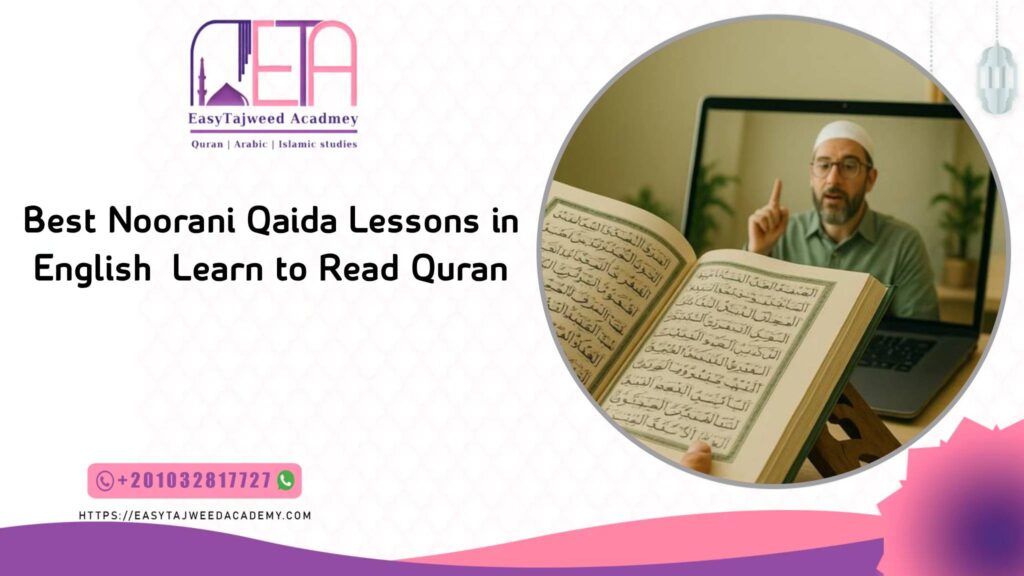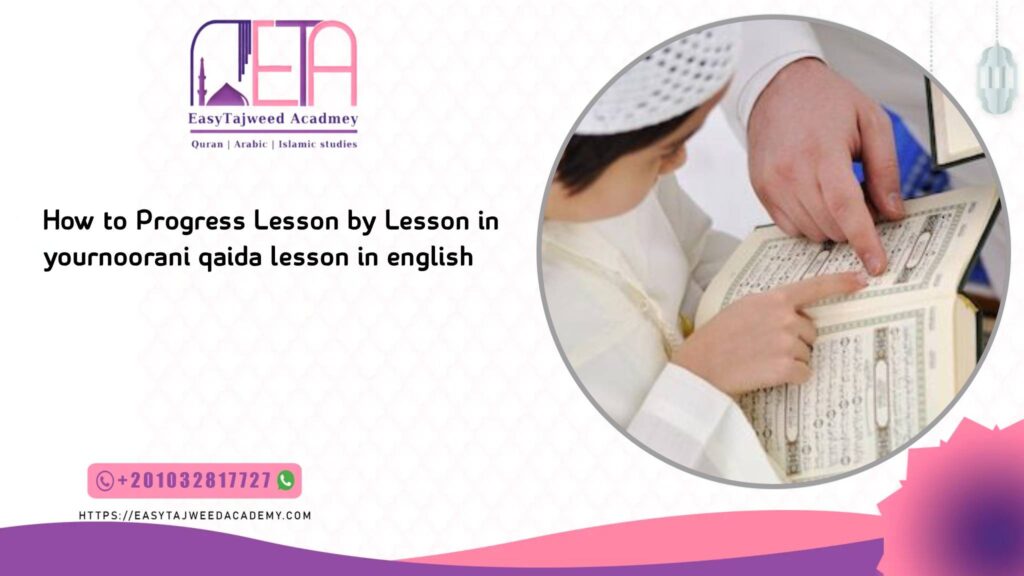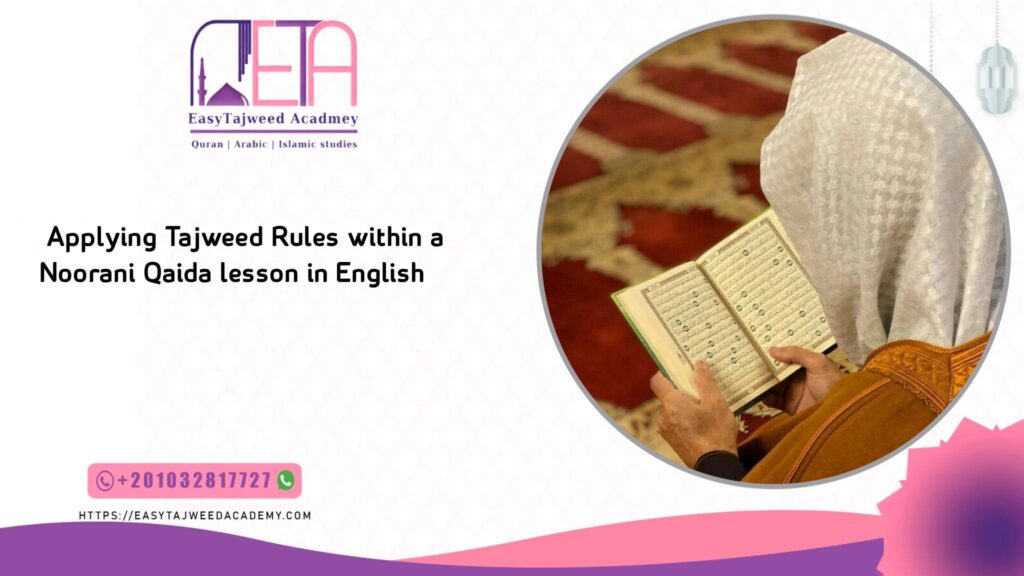This short guide introduces how the Noorani Qaida lessons in English help beginners across the UK build a clear foundation for reading the Quran. It presents the book as the first step toward accurate pronunciation and steady progress.
Noorani Qaida lessons in English start with the Arabic alphabet and the 29 letters, and they explain how each letter links to a sound and an articulation point. Learners will find at Noorani Qaida lessons in English page-by-page practice that focuses on letter shape, joining forms, and basic diacritical marks.
Practical practice in Noorani Qaida lessons in English emphasizes makharij so learners avoid common errors early. With short, friendly steps, both kids and adults can follow the same guide and move from letters to words, then to verses.
This introduction reassures readers that Noorani Qaida lessons in English, steady practice, and clear pronunciation work lead to confidence in reading the Quran and a smooth journey into mastering Tajweed Rules.
Key Takeaways
- The book serves as the first step and foundation for reading the Quran in the UK.
- Lessons teach the alphabet, 29 letters, and each letter’s sound and articulation.
- Practice on each page targets recognition, joining forms, and pronunciation.
- Focus on makharij strengthens pronunciation and prevents early mistakes.
- Short, structured steps suit kids and adults and build steady progress toward tajweed rules.

Getting Started with noorani qaida lesson in english: Foundations, Goals, and What to Expect
To master Quranic Arabic with online lessons, select a platform like Easy Tjweed Academy that offers courses at Noorani Qaida lessons in English with expert, often native, instructors, personalized learning paths, and interactive lessons.
Noorani Qaida lessons in English for Beginners start by mastering single letters, learning each glyph and its matching sound. This builds a clear foundation for accurate reading and steady progress. Short, focused pages guide practice so learners see progress each session.
Why this beginning matters
Noorani Qaida lessons in English break complex rules into small steps. Each page emphasizes one skill: letter shape, sound drills, or a basic rule. That structure reduces mistakes and builds confidence before tackling longer text.
Who benefits most
The guide suits the Noorani Qaida lessons in English for both kids, adults, and returning learners. School-age children gain early Arabic literacy. Adults refresh articulation and steady their pronunciation without pressure.
Learning outcomes
- Recognize letters on sight and link each letter to its sound.
- Develop correct pronunciation through simple drills and tongue placement tips.
- Learn light Tajweed rules and how diacritics change a letter’s sound.
Core Concepts You’ll Master in a noorani qaida lesson in english
This core section breaks down the main sounds and mouth positions learners must master to read Arabic with clarity. Noorani Qaida lessons in English map the 29 letters and show how each letter links to a consistent sound and place of articulation.
The Arabic alphabet overview: recognizing 29 letters
Noorani Qaida lessons in English begin by teaching the 29 letters so learners quickly recognize each letter and match it to its sound. Alif acts as a stretcher with no inherent sound; it lengthens vowel sounds without adding throat tension.
Heavy and light letters: خص ضغط قظ and ر
Eight heavy letters cluster as خص ضغط قظ. These keep the sound compact and full inside the mouth. The letter ر can be heavy or light depending on position, so practice comparing both forms on the same page.
Long vowel sounds (ا و ي)
Long vowels are simple: ا = AAA, و = UUU, ي = EEE. Stretch them naturally and avoid exaggeration. Short, repeated drills on a single page build consistency for later reading and tajweed rules.
Makharij: lips, tongue, palate, and throat
Makharij are grouped into roommate sets: ف و ب م use the lips; ت د ط use the tongue at upper tooth roots; ث ذ ظ use the tongue edges; ج ش ي use mid-tongue and palate; ح ع خ غ use throat zones. These comparisons speed recognition and improve pronunciation.
Common mistakes and quick practice
Watch for misplaced tongue positions for ت د ط and shaky edges for ث ذ ظ. Keep lips neutral when they are not the articulation point. Short pairing drills—compare two roommate letters per page—help learners feel the correct placement and lock in reliable habits.

How to Progress Lesson by Lesson in your noorani qaida lesson in english
A smart sequence at Noorani Qaida lessons in English helps learners move from isolated glyphs to connected script and simple words. This section outlines a clear, page-by-page route that keeps learning calm and steady.
From single letters to joining forms: start, middle, and end shapes
Step-by-step, learners see each letter in three positions: start, middle, and end. These snapshots train the eye to read quickly on the page.
Certain letters only connect on one side — for example, ا د ذ ر ز و. Highlighting these stops misjoins and prevents reading errors.
From letters to words: applying harakat and simple phrases
The guide introduces short vowels slowly: Fatha, Kasra, and Dammah. Each vowel gets small drills so learners hear and read words accurately through the Noorani Qaida lessons in English.
“Identify the letters, notice joins, add the vowel, then read the word.”
- Page roadmap: review letters → learn joins → read sample words → check end shapes.
- Practice prompts: 2–3 lines of joined script, then 2–3 short words per page.
- Mini decoding guide: spot letters, check joins, apply the short vowel, read smoothly.
Consistent short sessions—ten to twenty minutes daily—cement joining logic. This makes reading smoother each step of the way and builds confidence for further tajweed study.
Daily Practice Plan for noorani qaida lesson in english: Routines, Drills, and Feedback
A predictable 20-minute habit builds confident reading and steady articulation. This short routine fits UK schedules and keeps practice regular. Noorani Qaida lessons in English focus on letters, sound work, and quick reading to make learning measurable.
Short, focused sessions: a 20-minute routine
Five minutes: review recent letters and note tricky shapes.
Ten minutes: sound drills and makharij rotation for clear articulation.
Five minutes: read simple words aloud and mark pages for review.
Pronunciation drills: makharij-by-makharij practice
Rotate groups across days: lips, tongue-to-teeth, mid-palate, throat. This avoids overload and targets muscle memory. Use a short checklist: tongue placement, airflow, and sound containment.
Adapting for kids and adults
With Noorani Qaida lessons in English for Kids and adults benefit from the same plan, but with tweaks. Children get visual cues and playful breaks. Adults take slightly longer drills for faster gains.
Tracking progress and feedback
Log each page, which letters were mastered, and rules practiced. Set small goals like “master 3 letters” or “read 4 words.” Give micro-feedback: repeat a line until the sound is steady.
“Repeat a line until the sound is steady.”
| Session Segment | Time | Focus | Goal |
|---|---|---|---|
| Warm-up | 5 min | Review letters on recent pages | Recall shapes and sounds |
| Drills | 10 min | Makharij rotation & sound drills | Clear, repeatable sound |
| Reading | 5 min | Read simple words aloud | Smooth transitions and correct pronunciation |
Tips: Revisit tricky pages after a short break. Use steady, predictable practice to make the journey calm and rewarding. For learners who want more guidance, consider a free trial of the Noorani Qaida lesson in English online or a short Qaida online taster to compare methods and support.

Applying Tajweed Rules within a Noorani Qaida lesson in English
Introducing ghunna and qalqala starts with simple, repeatable sounds that build control and confidence. The book shows each effect on a single syllable before asking learners to try it inside a short word.
Ghunna, qalqala, and letter heaviness: integrating tajweed
The guide introduces ghunna gently. Learners feel a soft nasal resonance and avoid forcing air through the mouth. Practice drills focus on a short hum held for two beats.
Qalqala is taught as a contained bounce on the required letters. Pages show how to stop the sound cleanly so the echo stays crisp and steady.
- Heavy letters: lift the back of the tongue for a fuller sound.
- Light letters: relax the tongue to keep contrast clear.
- Practice step: syllable → short word → two-line read-through.
Mini-checklist: Is Ghunna gentle? Is the qalqala contained? Is this letter heavy here? Check the middle and end positions on the page.
“Small, kind corrections make correct pronunciation stick.”
Conclusion
This final note reminds learners that steady, small steps turn alphabet practice into clear, confident reading.
Noorani Qaida lessons in English give UK learners a dependable first step. Noorani Qaida lessons in English move from alphabet drills to letters, vowel sounds, and short words on each page. The guide of Noorani Qaida lessons in English helps readers recognize letter shapes and manage heaviness versus lightness for early tajweed.
They should keep a short daily routine and log pages covered, letters mastered, and words read. With focused practice, this Qaida book becomes the f
Keep returning to the same guide each day—each page is one clear step on the learning journey.
FAQ
What is the best first step to start learning Noorani Qaida lessons in English?
The best first step is to learn the Arabic letters and their basic sounds. They should focus on recognizing letters in their isolated form, practice short vowel sounds (fatha, kasra, damma), and try simple pronunciation drills. This builds a clear foundation for reading the Quranic text and for later tajweed study.
How long does it take to read simple words fluently?
With consistent daily practice of 15–30 minutes, many learners read simple words confidently within 4–6 weeks. Progress depends on age, prior exposure to Arabic script, and the quality of guidance. Regular feedback speeds development.
Who benefits most from these lessons — kids or adults?
With Noorani Qaida lessons in English, both benefit strongly. Children gain early phonetic habits and confidence, while adults often progress faster thanks to focus and discipline. Lessons can be adapted for different ages and learning styles.
How do Noorani Qaida lessons in English teach pronunciation and tajweed basics?
Noorani Qaida lessons in English start with makharij (articulation points) and basic vowel lengths, then introduce rules like ghunna, qalqala, and heavy vs. light letters. Practice moves from single letters to joined forms, short words, and rule application in small phrases.
What are makharij, and why do they matter?
Makharij are the articulation points of each Arabic letter — lips, tongue, palate, and throat. Correct makharij ensures accurate sounds and prevents common mistakes that change meaning in Quranic recitation.
How should a learner structure daily practice?
A short, focused routine works best: 5–10 minutes of warm-up letter drills, 10 minutes of word joining and reading, and 5–10 minutes of tajweed-focused exercises. Track pages, letters, and rules mastered to measure progress.
Can beginners learn proper pronunciation without a teacher?
Self-study resources, Noorani Qaida lessons in English, help, but guided feedback improves accuracy. Online tutors, recorded lessons, and pronunciation apps can correct errors that are hard to spot alone. A free trial lesson with a qualified instructor often helps identify priorities.
What are common pronunciation mistakes, and how can they be corrected?
Common errors include confusing similar sounds (ت vs. ط or ث vs. س), incorrect vowel length, and unclear makharij. Avoid these by isolating each letter, repeating makharij drills, and comparing recordings with a qualified reciter.
How do learners progress from single letters to reading full words?
Progress follows stages: learn isolated letters, practice joined forms (start, middle, end), add harakat (vowels), then read simple syllables and short words. Gradual steps and repetition prevent overwhelm.
Are there resources for kids in the UK who are learning these lessons?
Yes. Many centers, online academies, and apps offer child-friendly lessons with short sessions, colorful materials, and interactive drills. Choose programs that include native reciters and parent progress reports.
How do long vowel sounds (ا و ي) affect recitation?
Long vowels extend sound length and change syllable structure. Correct stretching is essential for accurate recitation and for applying the tajweed rules in longer phrases and verses.
What is letter heaviness, and which letters are affected?
Letter heaviness refers to letters that require a deeper or fuller pronunciation, like خ غ ق ص ض ط ظ. Understanding heavy vs. light sounds helps apply proper emphasis during recitation and improves clarity.
How should learners track progress effectively?
Use simple metrics: letters mastered, pages read without major errors, and tajweed rules applied correctly. Short weekly recordings show improvement and reveal areas needing review.
Are printable PDFs and books useful alongside online lessons?
Yes. A well-structured book or PDF offers step-by-step practice, clear examples, and space for written notes. Combine printed materials with audio and live feedback for the best results.
What role do tajweed rules play during early reading stages?
Early focus should be on clear pronunciation and basic rules like nasalization (ghunna) and qalqala. Introducing tajweed gradually helps learners build correct habits without overwhelming them.
How often should learners review earlier lessons?
Brief daily reviews of previous letters and rules are essential. Weekly consolidation sessions prevent backsliding and make new lessons stick faster.


